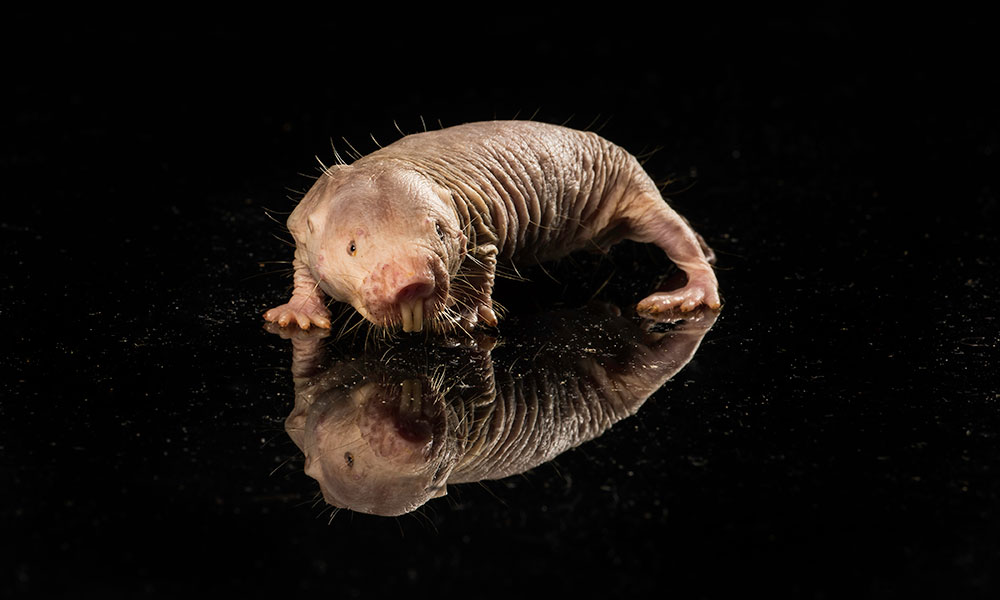The key to a naked mole rat’s cancer-free life?
Summary: Clues to the naked mole rat’s remarkable cancer-fighting abilities have been uncovered by researchers at the University of Rochester in a new study. [This article first appeared on LongevityFacts. Author: Brady Hartman. ]
With their wrinkled, hairless bodies, naked mole rats won’t be winning any beauty contests.
However, they do win longevity contests.
Naked mole rats have intrigued scientists with their long lifespan and exceptional resistance to age-related diseases such as cancer. These small mammals survive three decades or more, an exceptional feat considering that all other small rodents, such as a mouse, live only a few years. Moreover, these small mammals experience hardly any aging, causing researchers to dub naked mole rats as ‘the first non-aging mammal.’
That’s why three University of Rochester scientists studied naked mole rats to see if they possess a cancer-fighting mechanism called cellular senescence, and how it affords them protection against tumors. The scientists – professor Vera Gorbunova, professor Andrei Seluanov and Yang Zhao – published in their findings in the journal Proceedings of the National Academy of Sciences.
Cellular senescence is a protective mechanism that prevents damaged cells from developing into cancer. However, senescence also accelerates aging and produces chronic inflammation.
In fact, scientists have shown that they can rejuvenate mice by removing senescent cells with compounds called senolytics. However, many fear that removing senescent cells will strip away the body’s mechanism that protects against cancer, as Gorbunova says,
“In humans, as in mice, aging and cancer have competing interests,” adding “In order to prevent cancer, you need to stop cells from dividing. However, to prevent aging, you want to keep cells dividing in order to replenish tissues.”
Gorbunova and Seluanov have long researched cancer and its link to DNA repair and aging. The researchers have identified several mechanisms that contribute to longevity and cancer resistance in naked mole rats, including a chemical called high molecular weight hyaluronan (HMW-HA). However, they believe there are more pieces to the puzzle.
In their recent study, the researchers compared the senescence response of naked mole rats to that of mice, which live a tenth as long, as Seluanov says
“We wanted to look at these animals that pretty much don’t age and see if they also had senescent cells or if they evolved to get rid of cell senescence,”
The researchers discovered that naked mole rats experience cellular senescence, yet they continue to live long lives and minimal aging. In other words, the senescence mechanism does not shorten their lifespan, nor does it cause aging, as with other animals. As Gorbunova puts it,
“It was surprising to us that despite its remarkable longevity the naked mole rat has cells that undergo senescence like mouse cells.”
The researchers found that naked mole rats exhibit senescence just like mice. However, the naked mole rats’ senescent cells possess features that may resist cancer and promote longevity.
When a cell undergoes cellular senescence, it stops dividing but continues regular metabolic processes. The team at the University of Rochester found that, compared to other rodents, naked mole rats more strongly inhibit the metabolism of senescent cells, reducing the damaging effects of senescence. Simply put, naked mole rats have evolved with a more structured genetic code that enables them to live a long life, with minimal aging and minimal cancer. As Gorbunova says,
“In naked mole rats, senescent cells are better behaved,” adding “When you compare the signals from the mouse versus from the naked mole rat, all the genes in the mouse are a mess. In the naked mole rat, everything is more organized. The naked mole rat didn’t get rid of the senescence, but maybe it made it a bit more structured.”
Show Us Some Love
- Share this post on social media and help us spread the word– It only takes one click on any of the social media links on this page.
- Follow us on social media – Google+ or Reddit
- Sign up for our email list – We use your email to notify you of new articles. We will not send you spam, and we will not share your email address. You can cancel at any time.
- Tell us what you think – Scroll down to enter your comments below.
References
Cover photo: Naked mole rat. Credit: University of Rochester photo/J. Adam Fenster.
Lindsey Valich, “Another piece to the puzzle in naked mole rats’ long, cancer-free life.” The University of Rochester. February 6, 2018. Link to press release.
Yang Zhao et al. “Naked mole rats can undergo developmental, oncogene-induced and DNA damage-induced cellular senescence.” Proceedings of the National Academy of Sciences (2018). DOI: 10.1073/pnas.1721160115. Link to journal article in PNAS.
Disclaimer
Diagnosis, Treatment, and Advice: This article is intended for educational and informational purposes only and is not a substitute for qualified, professional medical advice. The information and opinions provided herein should not be used during any medical emergency or for the diagnosis or treatment of any medical condition. Consult a qualified and licensed physician for the diagnosis and treatment of any and all medical conditions. Experimental therapies carry a much higher risk than FDA-approved ones. Call 911, or an equivalent emergency hotline number, for all medical emergencies. As well, consult a licensed, qualified physician before changing your diet, supplement or exercise programs.
Photos, Endorsements, & External Links: This article is not intended to endorse organizations, companies, or their products. Links to external websites, mention or depiction of company names or brands, are intended for illustration only and do not constitute endorsements.
